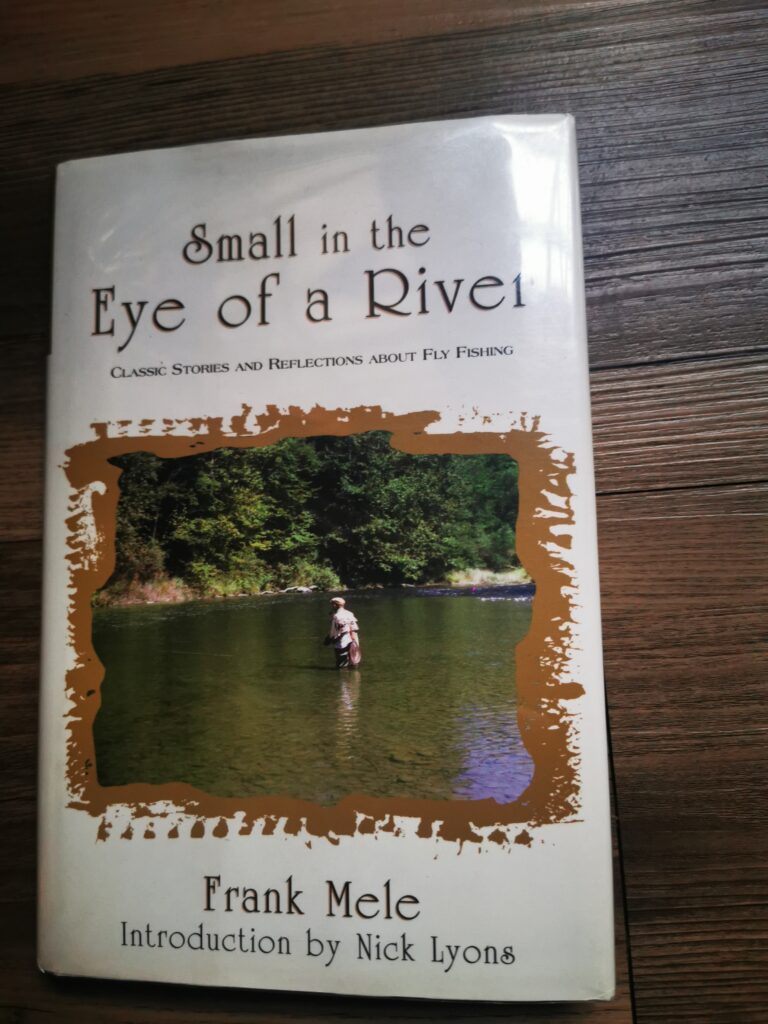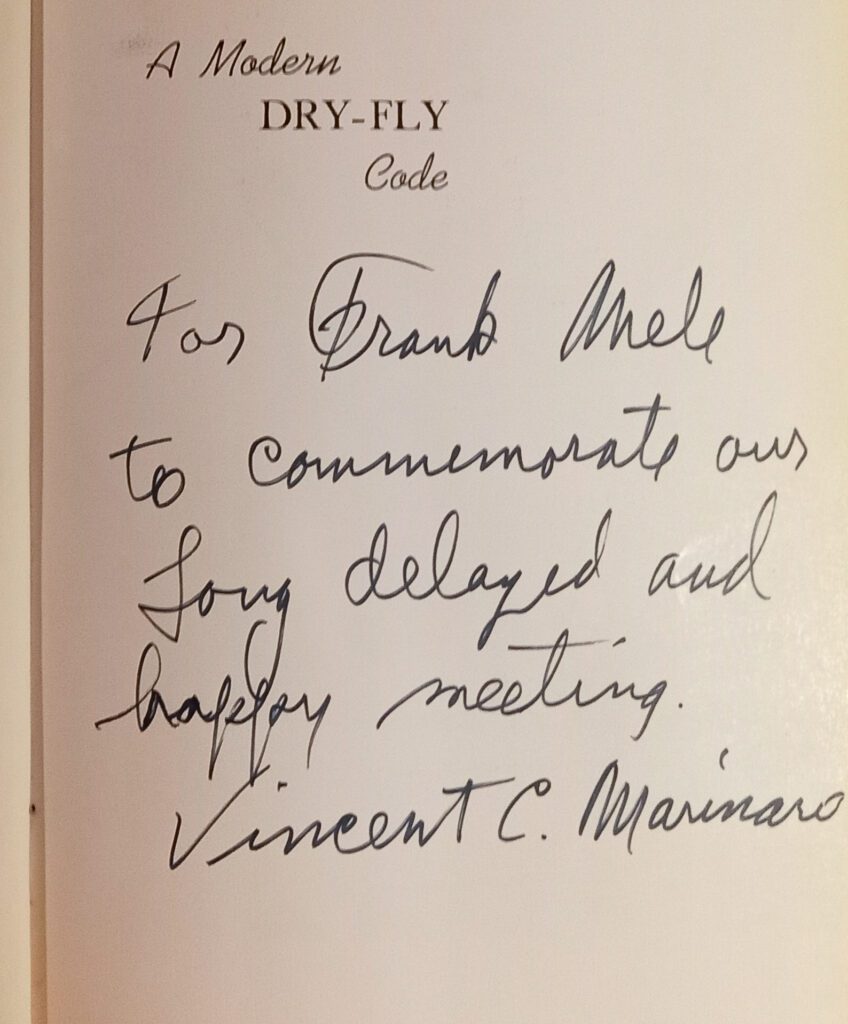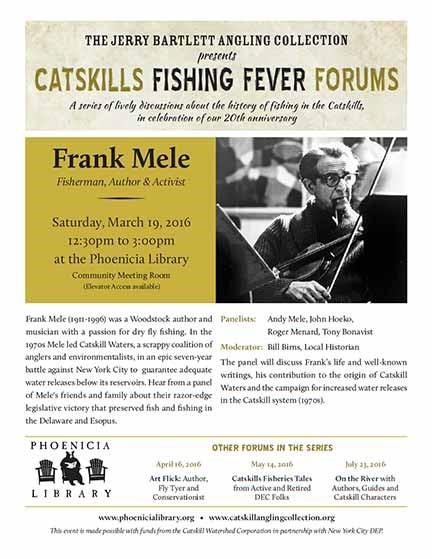It was late at night and I was nearing the end of a book I picked up at Huddy’s Books. The purchase had ended a hiatus in terms of my book collecting habit, brought about by my circumstances, but now I was relishing the pages of a book new to me. I turned the page on one story and started another. Something about blue dun capes. I read on a little, realizing that tiredness had overtaken my ability to truly digest what I was reading. On the second page I stopped. The piece was brilliant. Brilliant in the way of a rolling epic which spanned decades and transcended there here-and-now. I closed the book. I was too tired to appreciate this. It required relishing.
The next day I re-opened Nick Lyons 1973 “Fisherman’s Bounty” anthology on the story “Blue Dun”, by one Frank Mele.

For the next while I was spellbound. Each paragraph unrolled and soaked in, and I loved the read. Who was this author? How was it that I didn’t know of him? What else had he written?
As it turns out, these were questions that had been asked by other readers of Lyons book, decades earlier, and they too had gone looking for more.
Mele’s “Blue Dun” Story was written in 1970. It was later included in the anthology I was reading, and served to introduce the world to Mele. Coincidentally it was in 1970 that Nick Lyons published his own book, “Seasonable Angler”, and in that book is a story entitled “Mecca”, which Nick Lyons told me in a subsequent e-mail, was about Frank Mele (albeit under the pseundonym ‘Hawkes’), and more pointedly a days fishing in which Lyons was introduced to a man who was to become a friend.

Elsewhere in ‘Seasonable Angler’ Nick Lyons writes of a Payne rod which survived a house fire, and which he mentions needs to be sent to Mele for checking over. I later learned that the rod was given to Nick Lyons by Mele, and later when Mele fell on hard times Nick Lyons gave it back. Between re-reading Lyons book, and “Mecca” which I then learned was the first fly-fishing story Lyons ever wrote, I entered a delightful voyage of discovery.
Frank Mele wrote a book of flyfishing stories which was published in very small numbers in three separate editions, the first of which came out when I was a varsity student in 1988.. After his death in 1996, Nick Lyons brought the book to the wider angling world with a re-published edition, which I have since acquired, had shipped to me here in South Africa, and read. Read I might say, with a level of unsurpassed delight and enjoyment. It is an absolute gem of literature, as promised by Lyons in the foreword, which I first read online and which multiplied my determination to acquire the book. The title of the book is “Small in the eye of a River” (and not “the River” as erroneously printed in the earlier versions).

The writing is what I would describe as highly intelligent. The topics are broad and encompass a life view of enthusiasm, awe and respect, all loosely wrapped around the author’s unfailing love of flyfishing and music. His 30 page “Thoughts on flyfishing” unpacks his life-view and philosophy beautifully, immersing the reader in the topic, which he tackles more eruditely than most forays into this topic. Other stories are variously sweet and innocent, evocative, thought provoking and light. The book is unusual. I can’t think of any other book I could compare it to. I found one passage particularly moving: Mele had discovered Vince Marinaro’s “A Modern Dry Fly Code” after its first (and relatively unsuccessful) 1950 publishing, and had acquired a copy in a colourful way, which I will leave for you to read about. He had written to Marinaro to encourage him, and to praise him for his work. Twenty years later he was to meet Marinaro, who confided in him that after the first publishing he had become depressed about the publication, and how Mele’s letter had carried him forward and prevented him from giving up.

Such touching and epic anecdotes, which straddle decades and warm the heart are surely Mele’s forte!
Mele’s life was unique too. After descending deep down the Google rabbit hole late at night I uncovered insightful gems about him. Many of them were brief eulogies or short articles written by his former violin students, fishermen he had met, and friends. Nick Lyons filled me in a little and he introduced me to James Bendelius, a great friend of Mele, who shared with me the story he once wrote about ‘Goombah’, as he was affectionately known. Bendelius’ story appeared in the Bulletin of The Anglers’ Club of New York in 2008, and is in itself a moving and brilliantly written account of Mele, the man. One of my blog readers from the USA came forward to tell me that he owns one of Mele’s Payne rods. Jamie Bendelius still owns much of his collection of rods, books and other tackle.
In March of 2016, twenty years after his death, an event was held in which panelists told stories of his life and their encounters with him in a forum, with more in the audience who contributed to the memories of the man.

Included in the panel was his son Andy, whose career in environmental work was inspired by his father. The thirteen thousand word transcript of that forum is an insightful document, and takes the reader on a roller-coaster journey through Mele’s passion for bamboo fly rods, his truncated orchestral career, his cooking, his harsh tonque and short temper, and his boundless generosity. Very prevalent in this document and others is the story of how he mobilized to see to it that groundbreaking legislation was enacted to save his beloved Trout waters in the Catskills mountains, where NY city storage dams threatened to starve rivers of reasonable minimum flows. His legacy in this is truly something that has changed the face of flyfishing in the Catskill mountains for more generations than he would ever know.
The stories were personal and touching. He was a small and scathing man with deep set eyes and a big heart. Bendelius relates how the only time he saw a tear in Mele’s eye was when he gifted to him a rare book that he had been seeking for more than 50 years. Others recall the exact recipe of his pesto, and some relate his taste for liver, and sheep’s heads, and other carnivore’s delights that left some squeamish. A small group of passionate anglers who were cemented by the diminutive, argumentative Italian, called themselves “The Woodstock Anglers” and were clearly an institution, apparently still are.
The most recent piece I read was by his long time Friend Tony Bonavist and was placed online as recently as 2019.
Everything I read about Frank Mele is filled with colour. He had an immersive affliction for casting dry flies with a bamboo rod, which he did with a grace and style that impressed all those who watched him. Says James Bendelius : “ The Syracuse rod maker Dan Brenan was an early inspiration to Frank and his love for cane made Jim Payne a close friend. Frank would spend time at the Payne shop discussing the merits with Jim and later Walt Carpenter. He was always pursuing the ultimate bamboo rod.
Goombah knew cane rods. Not in the technical sense but in the artistic sense. “

He is referred to by many as a mentor, and others call him their ‘maestro’. His quest for the perfect rod lead him to the brink of financial ruin, and consumed him as much as his passion for wine, women and song. He loved to smoke an acrid pipe tobacco, drank coffee that could ‘melt the spoon’, and flung pasta at his ceiling to see if it was cooked. He wasn’t known for his cleanliness. He collected flyfishing books, and engaged in correspondence with some of America’s flyfishing greats. Amongst his friends was none other than Preston Jennings, the Darbees, Art Flick, and Dan Brennan, to name just a few. His humble home was a veritable train station of violin students, flyfishers, hackle breeders, political lobbyists and all whom he invited in to taste his sauces. He loved to write. His stories were apparently published in magazines, and he wrote a few books, but only one other, “Polpetto” was published (to critical acclaim). The rest of his material is relegated to papers in boxes in peoples’ houses, and in journals that pre-date the internet and don’t appear in searches. A few people said they had some papers, and ‘must go take a look to see if they can find them’.
In wading through all this material, and exchanging e-mails, it struck me that this was a man who was in many ways discovered appreciated and venerated long after his death. It is almost as though the world was slow to wake to what it had lost. I can’t help wondering what more he may have written, had he received the encouragement he himself gave to Marinaro during his living years.
I also can’t help hoping that something might trigger some of his old friends to go and dig in those boxes, find those papers, and see to it that they make it into the public eye. If that which was published is anything to go by, there would be a queue for a posthumous publication……..
Postscript: I am grateful to Jamie Bendelius, who, subsequent to the first posting of this story, sent me the two pictures of the inscribed books in his private library. I have inserted these in the post above in the relevant places. The first is in what was Mele’s copy of Nick Lyons book “Seasonable Angler” and the second is in Mele’s copy of “Modern Dry Fly Code”.
4 Responses
great stuff Many thanks Bohemian Bob
Thank you Bob,,,,all the best
I’m not certain when this may have appeared on the Internet, but I see Bob’s comment was from about two-and-a-half years ago. You mention a Payne fly rod that survived a fire and it was returned to Frank Mele, by Nick Lyons. It is very likely the Payne fly rod that is now in my possession – it’s a bit of long story, so I won’t bore you with it, now. I first met Frank back in the mid-1960s, and we had a 30-year friendship, until his passing in November of 1996, just after his 85th birthday. We had many a conversation at his residences(three of them: one on Yerry Hill Road, Woodstock, NY, one in Rhinecliff, NY, and one on Hillcrest Avenue, Woodstock, NY), in addition to many days astream in pursuit of those magnificent creatures, the trout. There were many meals together, as well. Frank was an excellent musician, a good cook, a very fine writer and a trout fisherman – one of the last of the old Catskill fly fishers to pass from our midst. Please do not hesitate to contact me if I can perhaps fill in any gaps. Thank you for reading.
Hi George,
Thanks so much for dropping this note. Yes, I posted this Frank Mele piece a while back, but I am glad you found it. It has created much interest and some delightful correspondence. The story of how the fire-rescued Payne came into your possession certainly won’t bore!…I will drop you a mail. Thank you for filling me in on your friendship with Mele!